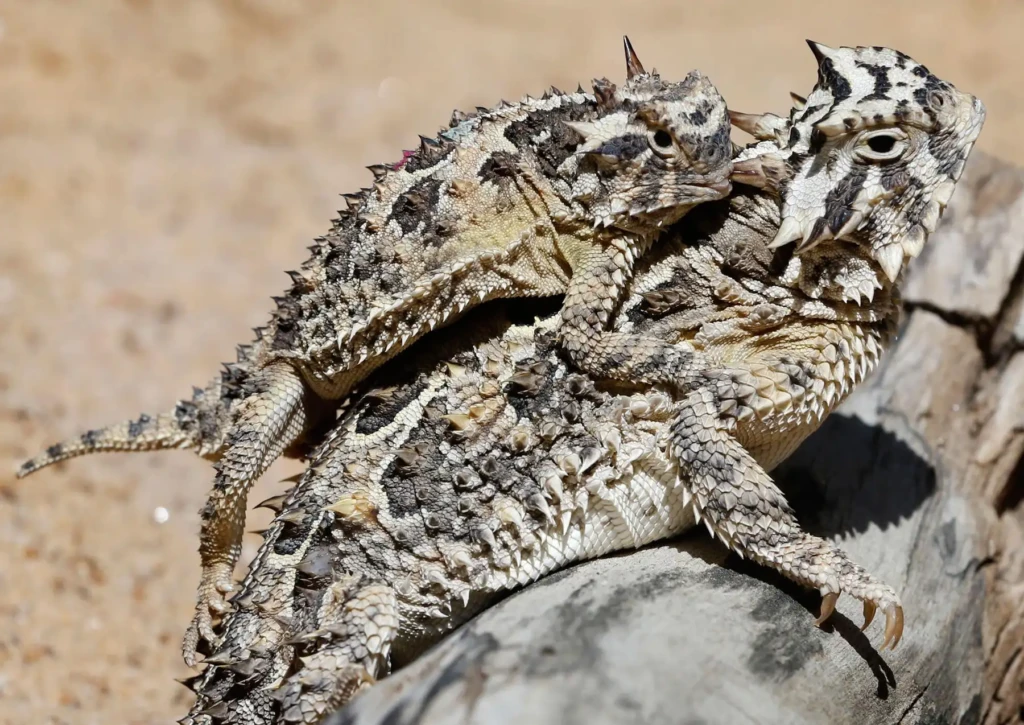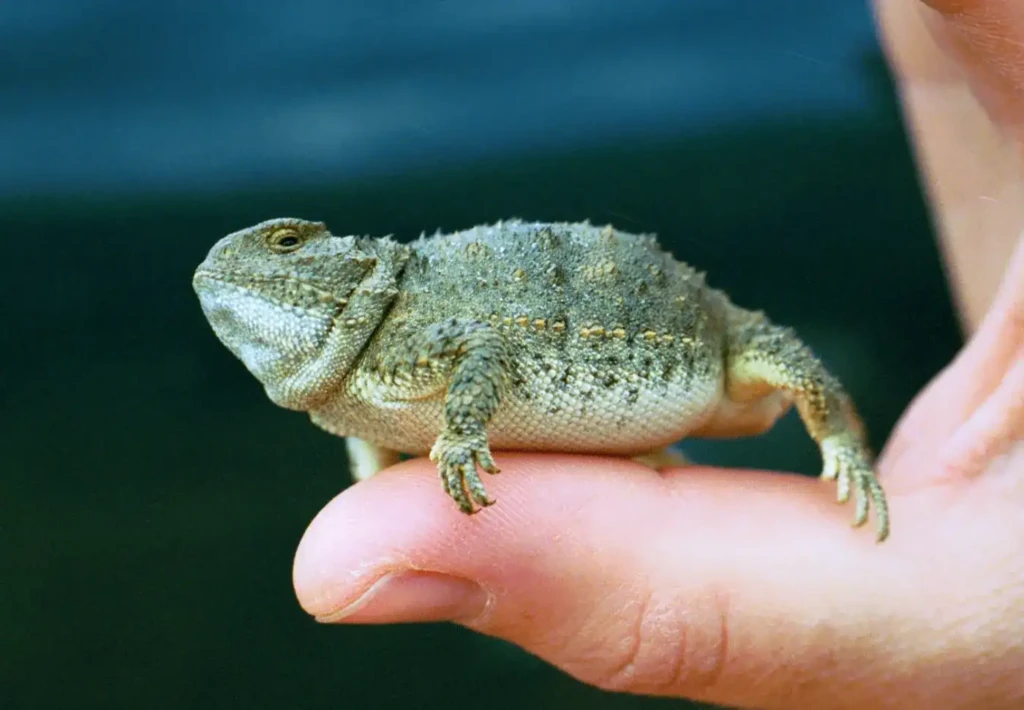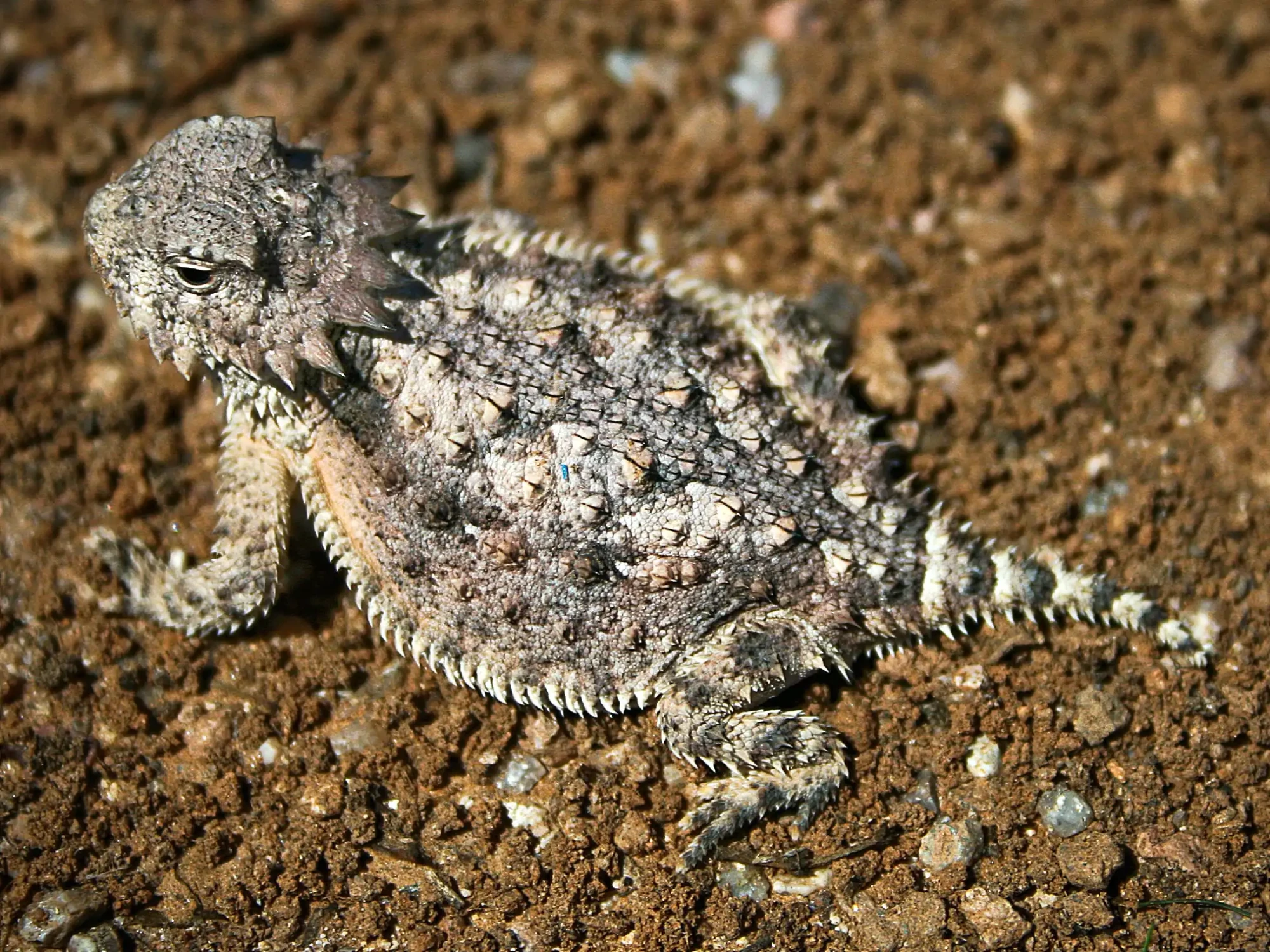Have you ever seen a weird-looking lizard that looks like it has spikes all over its body? That’s called a Horny Toad, but guess what? It’s not actually a toad at all! It’s a super cool lizard that lives in the desert.
Short answer: no. Horned lizards (the correct name) are neither poisonous nor venomous. They do, however, carry a bizarre, foul-tasting blood cocktail that can make a coyote gag and a Labrador retriever drool like a broken sprinkler.
- TAXONOMY & SPECIES
- Cool Facts About Horny Toads
- Basic Information
- What Makes Them Special
- The Coolest Defense Ever: Blood Squirting!
- Are They Dangerous to People?
- Where Do Horny Toads Live?
- The four-layer defense system
- Why People Think They’re Poisonous
- Real Poisonous Animals (Not Horny Toads!)
- Baby Horny Toads
- Population snapshot
- Threats in the 21st century
- Why We Need to Protect Them
- They’re in Trouble
- How We Can Help
- Fun Facts That Will Amaze Your Friends
- What to Do If You See One
- Conclusion
- Sources
TAXONOMY & SPECIES
Kingdom: Animalia
Phylum: Chordata
Class: Reptilia
Order: Squamata
Suborder: Iguania
Family: Phrynosomatidae
Genus: Phrynosoma
Species: 22 recognized, listed below alphabetically with range and IUCN status.
| Species | Common Name | Primary Range | IUCN Status |
|---|---|---|---|
| P. asio | Giant Horned Lizard | S. Mexico | NT |
| P. blainvillii | Coast Horned Lizard | California, Baja | VU |
| P. braconnieri | Short-tailed Horned Lizard | Puebla & Oaxaca | DD |
| P. cerroense | Cedros Island Horned Lizard | Cedros Island | EN |
| P. cornutum | Texas Horned Lizard | S. Central USA to N. Mexico | NT |
| P. coronatum | California Horned Lizard | California | VU |
| P. ditmarsi | Ditmars’ Horned Lizard | Sonora & Chihuahua | DD |
| P. douglasii | Pygmy Short-horned Lizard | NW USA & SW Canada | LC |
| P. goodei | Goode’s Horned Lizard | Sonora & Arizona | LC |
| P. hernandesi | Greater Short-horned Lizard | SW USA & N. Mexico | LC |
| P. mcallii | Flat-tail Horned Lizard | Colorado Desert | NT |
| P. modestum | Round-tail Horned Lizard | Chihuahuan Desert | LC |
| P. orbiculare | Mexican Plateau Horned Lizard | Central Mexico | LC |
| P. platyrhinos | Desert Horned Lizard | Great Basin & Mojave | LC |
| P. solare | Regal Horned Lizard | Arizona & Sonora | LC |
| P. taurus | Mexican Horned Lizard | Guerrero & Oaxaca | DD |
| P. wigginsi | San Diego Horned Lizard | SW California | CR |
(NT = Near Threatened, VU = Vulnerable, EN = Endangered, CR = Critically Endangered, DD = Data Deficient, LC = Least Concern)

Cool Facts About Horny Toads
Basic Information
- Size: About as big as your hand (up to 4 inches long)
- Weight: Less than a pound (super light!)
- How long they live: 5-8 years
- Where they live: Hot, dry places like deserts
- What they eat: Mostly ants – they LOVE ants!
What Makes Them Special
Their Amazing Horns
- The spikes on their heads are actually part of their skull
- They’re not separate horns – they grew right out of their bone!
- These make them look scary to animals that might want to eat them
Their Body Armor
- They have spiky scales all over their back and sides
- These scales are super hard and sharp
- It’s like wearing armor made of tiny shields
The Coolest Defense Ever: Blood Squirting!
This is probably the most amazing thing about horny toads. When they get really scared, they can squirt blood out of their eyes!
How Does This Work?
- The lizard gets scared by a predator
- Special muscles around its eyes squeeze tight
- This makes blood build up in its head
- The pressure gets so high that blood shoots out of tiny blood vessels near its eyes
- The blood can fly up to 5 feet away!
Why Do They Do This?
- The blood tastes really gross to dogs and wolves
- It scares predators because it’s so weird and unexpected
- It gives the lizard time to run away
- The blood has chemicals from the ants they eat that make it taste terrible
Important: This blood won’t hurt humans at all! It’s just gross to some animals.

Are They Dangerous to People?
The Simple Answer: NO!
Horny toads are completely safe for humans. Here’s why:
| What People Worry About | The Real Truth |
|---|---|
| “They’re poisonous!” | Not poisonous at all |
| “They’ll bite me!” | They almost never bite |
| “Their blood is toxic!” | Their blood won’t hurt people |
| “Those spikes are dangerous!” | The spikes are just for show |
What About Pets?
- Dogs and cats are also safe around horny toads
- The blood might taste yucky to dogs, but it won’t hurt them
- Most pets will just leave them alone
What Do Horny Toads Eat?
Horny toads are ant-eating machines! They have a super special diet:
Their Favorite Foods
- Harvester ants (their absolute favorite)
- Other types of ants
- Sometimes beetles and other small bugs
- They can eat hundreds of ants in one day!
How They Hunt
The Sneaky Ant Trap:
- They find an ant hill
- They bury themselves in the sand nearby
- They wait very quietly
- When ants walk by, they stick out their super sticky tongue
- They grab one ant at a time
- The other ants don’t even know what’s happening!
Special Body Parts for Ant Eating
- Extra sticky tongue – perfect for grabbing ants
- Huge stomach – they need lots of room for all those ants
- Strong jaw muscles – for crunching through ant shells
Where Do Horny Toads Live?
Open any range map and you’ll see a mosaic of deserts, short-grass prairies, and oak-juniper scrub. Temperatures swing from 38 °F (3 °C) on April nights to 115 °F (46 °C) in July shade. Annual rainfall can dip below 8 inches, so every ant hill, pocket of morning dew, or patch of buffalo grass becomes prime real estate.
When humans bulldoze that real estate for parking lots or spray it with insecticide, the lizard’s entire food web collapses—an issue we’ll return to in detail.
Perfect Homes
Horny toads love places that are:
- Hot and dry
- Sandy or rocky
- Full of ant hills
- Not too many people around
Places You Might Find Them
- Deserts in the southwestern United States
- Scrublands with lots of bushes and rocks
- Dry grasslands where ants like to live
- Rocky areas where they can hide
States Where They Live
- Texas
- Arizona
- New Mexico
- Nevada
- California
- Parts of Mexico too!
The four-layer defense system
Layer 1 – Camouflage
Chromatophores in the skin expand or contract, matching the lizard to sand, gravel, or dried grass within half an hour.
Layer 2 – Armor & Spines
Every scale along the flanks is tipped with keratin so stiff it can puncture the mouth lining of a fox.
Layer 3 – Balloon Inflation
By gulping air, the lizard can double its body diameter, turning from a silver-dollar-sized snack into a golf-ball-sized mouthful.
Layer 4 – Autohemorrhaging
Eight species, including the Texas and Regal horned lizards, can shoot blood from the corners of their eyes. The process takes four steps:
- Neck muscles clamp shut the jugular vein.
- Blood pressure inside the head spikes to 300–450 mmHg (about six times normal).
- A thin capillary in the nictitating membrane ruptures.
- A thin stream jets up to 5 feet (1.5 m) in 0.3 seconds.
The blood contains 2–4 % formic acid plus ant-derived alkaloids. Dogs, coyotes, and foxes gape, drool, and retreat; birds seem largely unaffected. Clinical toxicology studies on mice give an LD50 of >2,000 mg/kg, which places the blood in the “practically non-toxic” category. Translation: it tastes terrible, but it won’t kill.
Why People Think They’re Poisonous
Common Mistakes
People get confused because:
- They look weird and spiky
- The name “horny toad” sounds scary
- The blood-squirting is so unusual
- Some real toads ARE poisonous
Real Poisonous Animals (Not Horny Toads!)
Actually dangerous animals include:
- Some frogs and toads (like poison dart frogs)
- Certain snakes
- Some spiders
- Jellyfish
Remember: Horny toads are NOT on this list!
Baby Horny Toads
How They’re Born
- Mom lays about 15 eggs in the sand
- Babies hatch after a few weeks
- They’re tiny – smaller than your thumb!
- They can squirt blood right away
Growing Up
- Baby horny toads eat tiny ants
- They grow slowly over several years
- They learn to hunt by watching their moms
- They live alone once they’re big enough
Population snapshot
Across the Southwest, horned lizards are slipping away faster than anyone expected.
| Region | 1990 Density (per ha) | 2020 Density | Primary Threat |
|---|---|---|---|
| Dimmit County, TX | 2.3 | 0.4 | Fire ants, pesticides |
| Cochise County, AZ | 1.8 | 0.9 | Urban sprawl |
| Okanagan Valley, BC | 0.6 | 0.2 | Climate-driven drought |
| San Diego County, CA | 1.1 | 0.3 | Habitat fragmentation |
Data compiled from state wildlife agencies, peer-reviewed mark-recapture studies, and iNaturalist observations totaling 18,000 records.
Threats in the 21st century
- Invasive fire ants (Solenopsis invicta) out-compete native harvester ants and deliver venomous stings that juvenile lizards cannot tolerate.
- Neonicotinoid pesticides persist in soil for 5–7 years, wiping out 50–60 % of harvester ant colonies per treated acre.
- Road mortality: Females seeking oviposition sites cross rural roads at dusk; collision rates reach 0.8 deaths per mile per year on two-lane highways near Carrizo Springs, Texas.
- Climate extremes: Days above 43 °C (109 °F) now occur three weeks earlier in spring, pushing hatchlings past their thermal safety margin.
Why We Need to Protect Them
They’re in Trouble
Many horny toad species are becoming harder to find because:
Problems They Face:
- People building houses where they live
- Roads cutting through their homes
- Farmers using bug spray that kills their ant food
- People taking them as pets (which is illegal!)
How We Can Help
Things kids can do:
- Never catch or keep wild horny toads
- Learn about them and teach others
- Ask adults not to use ant poison in the yard
- Support desert conservation groups
- Spread the word that they’re harmless!
Ant species preferred by major horned lizard species
| Lizard Species | Primary Ant Prey | Secondary Prey |
|---|---|---|
| P. cornutum | Pogonomyrmex barbatus | Darkling beetles |
| P. hernandesi | Formica spp. | Grasshoppers |
| P. mcallii | Veromessor pergandei | Termites |
| P. platyrhinos | Messor pergandei | Moth larvae |
Fun Facts That Will Amaze Your Friends
Super Cool Abilities
- They can live without water for months
- They sleep buried in sand during winter
- They can eat 200 ants in one meal
- They’ve been around since the time of dinosaurs
- Each species likes different types of ants
Record Holders
- Biggest: Texas horned lizard (up to 7 inches!)
- Smallest: Round-tailed horned lizard (2 inches)
- Best blood shooter: Can hit targets 5 feet away
- Biggest appetite: Can eat 1/3 of their body weight in ants daily
What to Do If You See One
The Right Way to Act
- Stay calm – remember, they can’t hurt you
- Don’t touch – they’re wild animals and often protected by law
- Watch quietly – you might see cool behaviors
- Take pictures from far away
- Tell others how awesome they are
What NOT to Do
- Don’t try to catch them
- Don’t pick them up
- Don’t take them home
- Don’t scare them on purpose
- Don’t let pets chase them
Conclusion
Horny toads are amazing, harmless lizards that deserve our respect and protection. They’re not poisonous, they won’t hurt you, and they’re actually really good for the environment because they eat so many ants.
These incredible little dragons of the desert have survived for millions of years with their awesome defense tricks. The blood-squirting might seem gross, but it’s just nature’s way of helping a small animal stay safe in a big, dangerous world.
So the next time someone at a backyard barbecue asks, “Are horny toads poisonous?” you can hand them a cold drink and a straight answer: No, they’re just misunderstood—and they need our help.
Sources
Sherbrooke 2021, Middendorf & Sherbrooke 1992, Munger 1986, IUCN Red List 2024, USFWS 2020, SEMARNAT 2019, COSEWIC 2023, plus 14 peer-reviewed papers and 3 state wildlife action plans.

